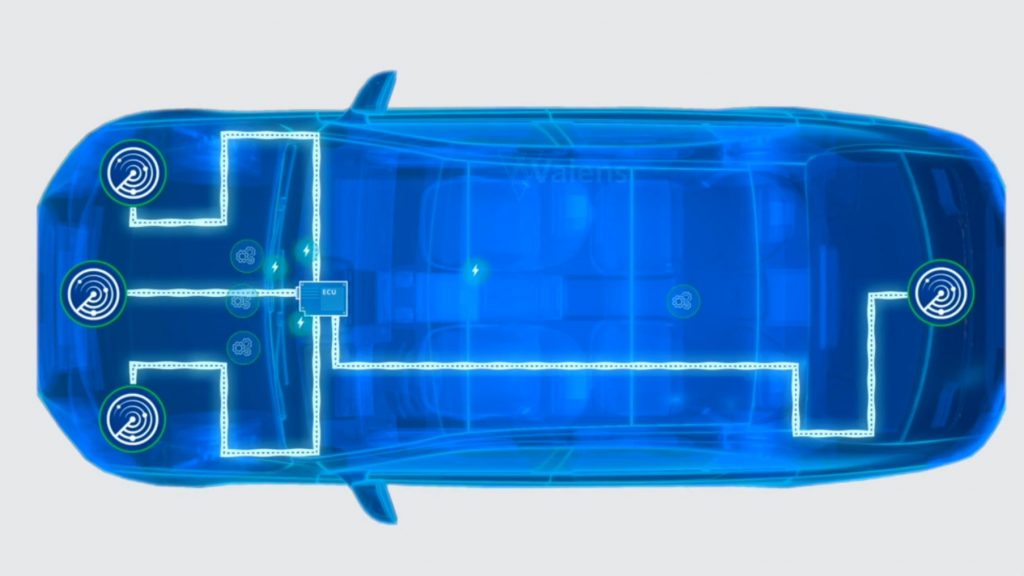
Most of today’s radar topologies are based on edge processing. In the radar sensor, a fairly powerful processor takes in the raw radar data, crunches it, compresses it, and sends low-bandwidth data to the central ECU.
As the industry moves forward toward higher levels of autonomy and the software-defined vehicle of the future, “we need to move to centralized processing,” explained Daniel Schwartzberg, Director of System Solutions at Valens Semiconductor. “To achieve that, you now need very high bandwidth, reliable links from the radar, moving raw data directly from the radar sensor to the centralized processor.”
This week at the AutoSens Detroit, Valens officially announced a new concept that it says will make radar implementations smaller, simpler, and less costly. Executives believe that the company’s Satellite Radar with Centralized Processing will change the game for in-vehicle sensing on the road to higher levels of autonomous driving.
They say it will address radar (and other) sensor connectivity solution limitations on both the downlink and uplink; that is, radars have needed to send and receive more data than they were able to.
On the downlink, radars generate massive amounts of data that need to be transferred to a central compute unit. Because there has been no connectivity solution able to handle that amount of data, radar vendors have had to include processing elements within the radars. That way, instead of sending along high-bandwidth raw data, the radars can send low-bandwidth, pre-processed data to the central unit. Of course, the addition of the processing within the radar adds cost, complexity, and size to radars located in vulnerable locations in the vehicle, which is sub-optimal.
On the uplink, radars require high-bandwidth controls to ensure proper ongoing operation. This is unlike cameras, which only require low-bandwidth frame synchronization. Radar vendors have used I2C (Inter-Integrated Circuit), and more recently SPI (Special Purpose Identification) connectivity, but existing solutions have only been able to supply up to around 3 MHz for these controls. This has limited the radars’ usefulness, lengthening the time for activation and making it harder to handle chirp.

Valens’ new concept overcomes all these challenges. Leveraging its MIPI A-PHY-compliant VA7000 chipset family, it says that companies will be able to transform the automotive industry with a new generation of radars.
The company’s VA7000 can take up to eight gigabits of raw data from the radar and extend it out over a link of up to 15 m (49 ft) of coax or 10 m (33 ft) of shielded or unshielded pair cable while meeting all of the industry requirements for electromagnetic compatibility. And in the uplink direction, it has SPI controls, which are what the MIMIC (Microwave and Millimeter Wave Integrated Circuit) chips in the radar require.
“This is a great solution for providing lean radars without edge processing and moving the processing to a centralized location,” said Schwartzberg.
Korea’s SRS has already implemented Valens’ solution on its satellite radar car architecture.
“They tell us that this radar with no edge processing is one-quarter the size of their existing product,” said Schwartzberg. “And it allows them to move, over unshielded wiring, all that raw data from the MIMIC chip down to the centralized processor.”
The architecture enables direct raw data transfer across the link for improved radar perception through centralized processing for multiple sensors. Schwartzberg showed an example of 12 radars distributed around a vehicle, all of them feeding raw data down to centralized processing.
“This is a POC that is ongoing with a major global OEM,” he said. “So, this is not just a theoretical approach to radar architectures. This is actually something being implemented today in the industry.”
Momentum is building for the MIPI A-PHY connectivity standard, which has been adopted by IEEE; evaluated by more than 30 OEMs, Tier 1s, and Tier 2s; and is based on Valens’ technology. Its chipsets are the first in the industry to be compliant with the standard for use in a range of applications including for camera and lidar sensing.
Valens’A-PHY collaborations with some of these industry leaders including Mobileye for 8-15 MP camera connectivity, Innoviz for raw LiDAR data distribution, Sony Semiconductor Solutions for surround view systems over unshielded twisted pair cables, and Omnivision for time synchronization with two of its sensors.

